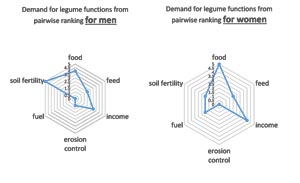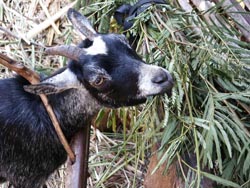N2Africa followers do not need convincing about the benefits of legumes to smallholders. Yet, legumes mean different things to different people. Agro-foresters may think of tree legumes, livestock specialists may interpret legumes to mean forages, while to crop agronomists legumes tend to be grain legumes. Legumes are indeed a diverse class of plants – they are diverse in form: from the mighty Acacia to the diminutive white clover. They are also diverse in function and contribute multiple benefits to farmers: food, income, feed for livestock, fertility for following crops, protection of soils from erosion and so on. Making sense of this diversity of form and function among legumes could help us to match up different legumes with the needs of smallholder farmers. And this could improve adoption of legumes by farmers from the current low base. This targeting of legumes to niches in smallholder systems is the core objective of the Legume CHOICE project. Better targeting could help us get away from the prevailing fragmented approach to legume development in Africa. This could lead to legumes playing a more prominent role in farming systems by providing protein nutrition for families, improved feeding for livestock and environmental benefits through improved soil fertility. The International Livestock Research Institute (ILRI) has been leading the development of a decision support tool (also called Legume Choice) as one component of the Legume CHOICE project. The evolving tool is essentially a list of different legume options. Each option has been scored by experts for its contribution to a series of functions in smallholder systems: food, income, feed, soil fertility and so on. This is the supply side. The tool includes a community needs assessment where farmers can express their demand for the various benefits that legumes can provide. Matching scores for supply and demand allows prioritization of legumes into a shortlist of promising options that can then be tested with farmers. The prototype tool has been applied in Ethiopia, Kenya and Democratic Republic of Congo as part of the Legume CHOICE project. Preliminary feedback shows it to be useful but points to the need for a further component where agro-ecological suitability of legumes is also assessed. This component will be developed in this, the final year of the project. The Legume CHOICE project is funded by the German Federal Ministry for Economic Development and Cooperation (BMZ) and led by the International Institute for Tropical Agriculture (IITA) with ILRI, the World Agroforestry Centre (ICRAF), Oromia Agricultural Research Institute (OARI), Kenya Agriculture and Livestock Research Organization (KALRO) and the Catholic University of Bukavu as key partners.
 |
Left: Example output from Legume CHOICE tool Right: West African dwarf goat eating Calliandra, Cameroon |
 |
By Alan Duncan
